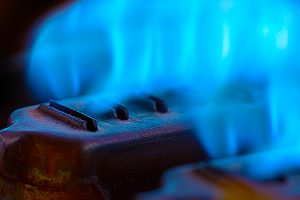Safe operation of any fuel-fired equipment requires adequate combustion air supply. To provide this essential system component, technicians typically install openings constructed of metal ducts or fixed grilles. This provides air from the outside or from an adjoining part of a building.
Since combustion air openings are ducts, let’s look at the variables affecting airflow through them. As you read, consider this: do you overlook this indispensable element of a well-performing and safe HVAC system? Let’s find out what makes them work and consider some often-needed repairs.
Airflow Basics
To understand the operation of combustion air ducts and registers, it’s a good idea to review some airflow basics. For airflow to move through a combustion air opening, there must be a pressure difference across it created by an external source. Therefore, traditional installations depend on natural forces to create this pressure difference.
Following is a summary of these forces:
- Air takes the path of least resistance.
- Air moves from a higher pressure to a lower pressure.
- Heated air rises, colder air falls.
- 1 cfm in = 1 cfm out
- Airflow can’t read a code book or follow arrows. I know, obvious, right?
Knowing this, think about how these forces could be controlling combustion air in your installations.
Combustion Air Configurations
The typical combustion air installation most of us are familiar with dates back to the 1950s. This was when two openings became the standard practice to provide proper ventilation into a confined space with fuel-fired equipment in it. To this day, we commonly use one square inch of opening per 1000 – 4000 Btu of input as a rule for sizing.
Three commonly installed combustion air configurations include ducted horizontally, vertically, or through a louvered door.
First, code requires Horizontal combustion air ducts have one duct installed 12 inches from the top and bottom of the mechanical room. Typically these ducts connect to a heated part of the building or directly to outdoors. Furthermore, common sizing protocols state the need for one square inch per 1000 Btu input for ducts terminated in an adjoining heated area and one square inch per 2000 Btu input for ducts terminated directly to the outdoors.
Next, code also requires that Vertical combustion air ducts have one duct to be within 12 inches of the top and bottom of the mechanical room. Installers usually terminate these ducts to the outdoors, or to an area that communicates with the outdoors, such as an attic or crawlspace. Vertical installations allow more input per square inch of opening than horizontal installations. Ducts tied directly to the outdoors or areas that communicate with outdoors, such as an attic or crawlspace, need one square inch per 4000 Btu input.
Louvered doors are the last type of combustion air opening we typically use. They join the equipment with the rest of a building through the access door to the mechanical room. Technicians usually ignore sizing with a louvered door and they use the one that closest fits the rough opening. An important item to remember with this type of installation is communication between the room and any airflow interactions taking place in the rest of the building.
Combustion Air Influences
Since natural forces control air movement through a combustion air opening, consider the influence of wind on horizontal installations. If you install combustion air ducts where wind blows into them, all is well. Air blown into it pressurizes the room.
What do you think happens to combustion air ducts installed on the opposite side of a building where the wind doesn’t blow? If you guessed they would pull air out of the room, you’re correct. Kind of scary, isn’t it?
If you install combustion air ducts where wind blows into them, all is well.
Vertical installations are also subject to the fundamentals that drive air movement. These openings often exhaust air from a room instead of supplying it. This is due to a phenomenon known as stack effect — caused by heated air rising. Flow through these ducts reverses as warm air rises, escaping the building.
Visualization
To visualize this for yourself, hold a piece of single ply toilet paper at the bottom of these ducts and see what happens. If you see the toilet paper pull into the duct, it is exhausting air. Instead, it should blow the toilet paper into the mechanical room indicating air is flowing in from outdoors. Unfortunately, if air does flow in, you might have larger problems to deal with since it isn’t the norm.
These openings are two way paths and can easily pull air out of a room instead of supplying it. If air exhausts through a combustion air duct, we should question where the air to replace it comes from. The source can easily be from a flue pipe.
We can truly understand the impacts of these installations now that we measure them. The good news is you can measure the performance of your combustion air ducts too. You can verify what is really happening to your installations.
Now let’s consider the impacts of air balancing, duct leakage, central returns, interior door closure, and large exhaust fans. They can create large airflow imbalances and create a massive competition for combustion air. Another unfortunate side effect is to cause flue gas spillage making fuel-fired equipment unsafe.
Combustion Air Solutions
Fortunately, there are solutions to these problems when you use your knowledge of airflow the right way. The same forces causing combustion air openings to reverse can be used to correct them. Ironically, some of these solutions might be viewed as code violations.
- Combustion air traps can be used to keep warm air from rising and exhausting through the combustion air openings. A plug of colder air in the trap prevents the stack effect by using air density differences in a corrective way. On round ducts, technicians commonly install them using elbows back-to-back to form a trap or by placing a five-gallon bucket under the lowest duct.
- Fan powered combustion air can be used to overcome natural influences that reverse the flow of combustion air. This requires bringing outside air in via a dedicated fan and used to pressurize a mechanical room when equipment is in operation. It can be also interlocked with electrical safeties to provide an additional layer of safety to prevent equipment operation if the fan fails to energize.
Time to Stop Assuming
Combustion air requirements meet national codes but the airflow through these openings is clearly left to chance. Do the current sizing protocols account for a means of consistent airflow to equipment relying on natural air movement alone? I’m hoping you begin to question this.
We can truly understand the impacts of these installations now that we measure them. The good news is you can measure the performance of your combustion air ducts too. You can verify what is really happening to your installations.
In conclusion, a quick draft pressure measurement provides a tremendous amount of information about air movement in a combustion air duct and flue pipe. With the test instruments and training available today, it’s time to stop assuming combustion air performance and start to consistently deliver it.
David Richardson serves the HVAC industry as a curriculum developer and trainer at the National Comfort Institute, Inc. (NCI). NCI specializes in training focused on improving, measuring, and verifying HVAC and Building Performance.
If you’re an HVAC contractor or technician interested in learning more about airflow measurement, contact David at davidr@ncihvac.com or call him at 800-633-7058. NCI’s website www.nationalcomfortinstitute.com is full of free technical articles and downloads to help you improve your professionalism and strengthen your company.







Leave a Reply
You must be logged in to post a comment.